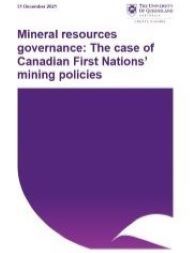A case study of Canadian First Nations’ mining policies
To remedy a locally defined gap in the mineral resources governance system, Canadian First Nations are developing their own governance instruments. This study examines mineral resources governance in the context of Canadian First Nations’ mining policies. Eleven policies, which represent 28 First Nations within 11 broader First Nation groups, were analysed. The First Nations span six Canadian provinces and territories and one US state.
The study found consistency in the function and content of the policies and diversity within their form. The primary driver for producing a mining policy is asserting jurisdiction over traditional territories. The mining policies establish the terms and conditions required for First Nations to consent to mining activities on their land. They clarify the decision-making process, specify criteria, articulate values and principles, present a consistent process, and provide greater certainty for proponents. They also specify the extent of the First Nation’s territory and most of the policies provide maps for that purpose. Other key objectives identified include protection of the natural environment within traditional territories, including an explanation of the nation’s environmental values; maximising the benefits of mining to communities; specifying a clear engagement process; and encouraging progress towards formal agreements with proponents.
Language: English
Publisher: The University of Queensland
Region: North America
Type: Report
CITATION
Worden, S. (2021). Mineral resources governance: A case study of Canadian First Nations’ mining policies. Brisbane, Australia; Centre for Social Responsibility in Mining, University of Queensland.

